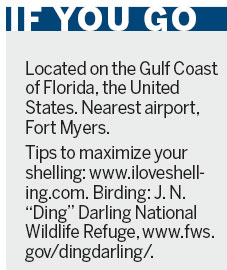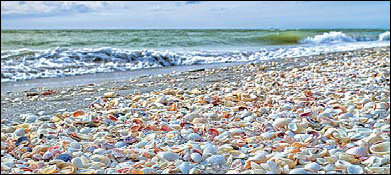Quiet beaches on Florida's Sanibel Island
Updated: 2013-01-02 07:31
By Associated Press in Sanibel, Florida (China Daily)
|
||||||||
|
Sanibel Island boasts itself as one of the best shelling sites in the world. Provided to China Daily |
Visit the beaches on this Gulf Coast barrier island and you're likely to see people doing the Sanibel Stoop. That's the term for the bent-at-the-waist posture used to collect seashells on Sanibel Island, which bills itself as one of the best shelling locations in the world.
The island also offers 24 km of beach, 35 km of bike paths, and the largest undeveloped mangrove ecosystem in the United States. While other beach destinations in Florida might attract partying spring breakers or glamorous fashionistas, Sanibel proved to be the perfect spot for a family looking for a quiet beach retreat at the height of spring break revelry. What we didn't find was nightlife, highrises, chain stores, fast-food burger joints, traffic lights or insects.
Even travel guru Arthur Frommer, who's seen more than a few beaches, has named it a favorite destination, calling it an "idyllic haven of white-sand beaches" with "thousands of birds of every species".
The first sign that we'd hit on something special came soon after we landed at the Fort Myers airport, where tourism kiosks handed out free pocket-sized Lonely Planet travel guides to the area.
The drive from the airport west to Sanibel generally takes less than an hour, but timing is everything. A toll bridge connects Sanibel to the mainland, and the morning rush hour heading on-island and evening rush hour heading off-island can add another 45 minutes onto the trip during high season, which begins mid-January and peaks mid-March through mid-April.
We stopped en route at one of the several Publix markets to stock up on groceries for our rented condo. But it turned out that two markets on the island, Jerry's Foods and Bailey's General Store, will deliver items ordered online to your rental for $25. Groceries also proved largely unnecessary once we discovered the caliber of local restaurants and opted to eat out most evenings. Traders Cafe and Mad Hatter, both innovative and outstanding, took reservations. Others had "call-ahead seating" which put our name on a waiting list ahead of the walk-ins. The rest generally had a wait of up to 30 minutes.
With as many as 30,000 people on the island during high season, biking is the easiest way to get around. But here's a tip: Friends don't let friends ride at night without lights.
Knowing that we'd be biking, we brought our helmets (required by law for children under 16), along with small headlights and taillights for our bikes. Even so, with no streetlights on the island and plenty of pedestrians and cyclists on the paths after dark, the trip home proved hairy.
Some hotels provide bikes for their guests and the bike rental shops on the island will deliver and pickup for a fee. It pays to shop around as prices vary. Beach equipment can also be rented.
Golf, tennis and fishing are also popular options on the island, but no trip here would be complete without two things: the beaches and the J. N. "Ding" Darling National Wildlife Refuge.
Over two-thirds of Sanibel is a nature reserve, with the refuge making much of it wonderfully accessible by car or bike. We opted for a 90-minute kayak tour through the mangrove, and almost immediately caught a brief glimpse of a river otter. An assortment of the 230 species of birds on the island from anhingas to woodpeckers kept us busy taking pictures, while our knowledgeable guide pointed out horseshoe crabs, flying mullet and a water snake.
We so enjoyed the trip through the mangrove that we returned later for a pontoon boat tour, where we saw manatees and more birds, but unfortunately, no dolphins.

The beaches themselves were lovely. The one we frequented was far from crowded, with room to play Frisbee or fly a kite without bumping into anyone. The waves were gentle and it was shallow for a long way out, making it ideal for children. Other beaches, like Blind Pass, have stronger currents and aren't suitable for swimming.
A small disappointment for us ironically was the shelling. The 16-km-long island is situated east-west, making the south side the place to scoop for shells being carried on the current from the Caribbean and other southern seas.
The beaches we explored had an infinite number of shells, but they were run-of-the mill cockles and clam. We didn't find any of the whelks, conchs, tulips and ceriths that feature prominently in the marketing brochures. Then again, we weren't beach-combing at dawn like the true devotees, nor did we follow the recommendations to check the tide tables, snorkel for shells or search after dark.
But there are plenty who do take the shell hunt quite seriously. Among Sanibel's claim to fame is a Guinness World Record for the largest treasure hunt, set last February when 478 people simultaneously did the Sanibel Stoop, searching for seashells.
(China Daily 01/02/2013 page10)

 In Photos: 7.0-magnitude quake hits Sichuan
In Photos: 7.0-magnitude quake hits Sichuan
 Li Na on Time cover, makes influential 100 list
Li Na on Time cover, makes influential 100 list
 FBI releases photos of 2 Boston bombings suspects
FBI releases photos of 2 Boston bombings suspects
 World's wackiest hairstyles
World's wackiest hairstyles
 Sandstorms strike Northwest China
Sandstorms strike Northwest China
 Never-seen photos of Madonna on display
Never-seen photos of Madonna on display
 H7N9 outbreak linked to waterfowl migration
H7N9 outbreak linked to waterfowl migration
 Dozens feared dead in Texas plant blast
Dozens feared dead in Texas plant blast
Most Viewed
Editor's Picks

|

|

|

|

|

|
Today's Top News
Live report: 7.0-magnitude quake hits Sichuan, heavy casualties feared
Boston suspect cornered on boat
Cross-talk artist helps to spread the word
'Green' awareness levels drop in Beijing
Palace Museum spruces up
First couple on Time's list of most influential
H7N9 flu transmission studied
Trading channels 'need to broaden'
US Weekly

|

|








